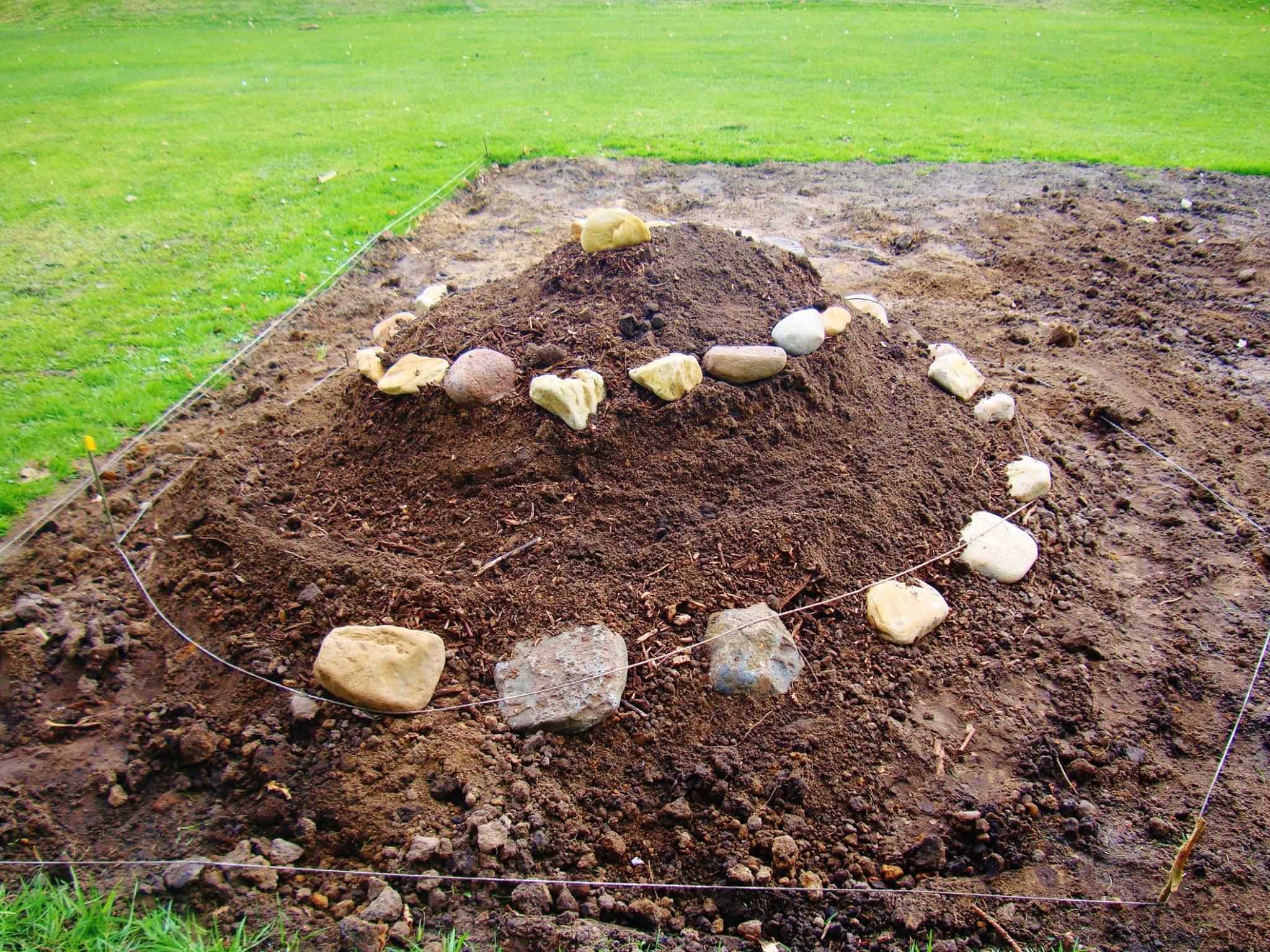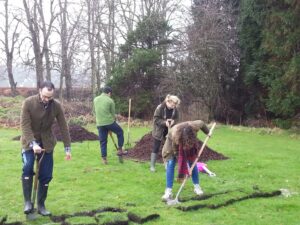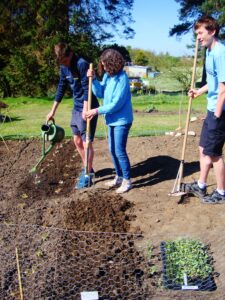By Charlotte Davis – Garden Organiser at University Hall Community Garden
The original University Hall vegetable patch exists now only in history books, but when the idea restoring a hall veg patch were floated last autumn we were assured that it had once been a central part of hall life. We had greenhouses in between Westerlee (now Wardlaw) and Old Wing and there is a photograph from 1916 of Hall residents digging up potatoes more-or-less exactly where our garden is now. Certainly a garden of some sort would have been in the grounds of the hall from its foundation in 1896 and for much of its history University Hall would have been largely self-sufficient, and certainly would have organised all the catering itself, in the absence of a centralised catering system.
This information was inspiration enough and spurred on a crack team of volunteers of all levels of experience who were soon marking out, double digging, raking and fencing frantically to get the plot ready for planting this spring. And it looks wonderful!
On a cloudy day in October Ali and Jasper from Transition St Andrews tentatively asked if the motley group of Uni Hallers gathered thought that a community garden was a realistic prospect. People were quiet, unsure of how to make the idea a reality. We had no experience of setting up gardens and it seemed far out of reach.
I was keen. I’d seen and helped with projects like this before and seen what they could become, what joy they brought to the people involved, but never in Scotland and never from scratch. Yet the more we talked, wondered, planned and looked at what the other St Andrews gardens had done, the more excited we became. The turning point was when Jasper took Taylor, Uni Hall’s Senior Student, and I to mark out the potential plot. It was green lawn, bare and uninteresting, but as soon as the string went down all three of us began to believe it was really possible. I could picture it, and with that concrete aspiration, everything started to fall into place.
I found myself googling, researching and reading endless articles and gardening manuals late into the night. By the time spring brought with it eager volunteers, our plan had crystallized. I wasn’t the only one whose imagination had been piqued by talk of a garden and as the weather improved the shovels came out, raspberry canes went in and there was a real buzz around hall about how it would all come together. By this point we had over 40 members of the Facebook page where we were publicising our plans. With the help of Transition, lots of pairs of hands and a lot of motivational singing we double dug the plot. With each square of turf that disappeared beneath the rich piles of soil, scientifically tested by Transition’s soil expert, Sarah, our idea was becoming a reality.
We presented our plan to Chef Ross who enthusiastically agreed to use what we could grow in his menus. This gave us an aim; to provide food from the hall grounds to feed the residents. A real step towards the ideals of sustainability and responsible eating as well as restoring the old traditions of the hall. With confirmation from Sandra, our Hall Manager, that we could use the hall greenhouse for seed propagation we planted out endless seed trays anxious to have a diverse, productive and beautiful array of plants.
Soon our seedlings had sprung up, ready to plant out. Despite our eagerness to get our tender seedlings in the ground we faced a problem. Rabbits. Big, hungry rabbits. We didn’t want a re-enactment of that scene from Wallace and Gromit’s Curse of the Ware Rabbit – every gardener’s nightmare. The solution was kitchen wire and the girls were on the case. After sessions of macho digging competitions, it was the girls’ time to shine. With some precision measuring, wire cutting, staking and attaching an incredibly professional and utterly (we hope) rabbit proof fence bordered the plot. This was a symbolic as well as practical step for the garden – it demarcated it as an area distinct from the rest of the land; valuable, special and most importantly ready for plants.
Rhubarb crowns were given their own bed while beans were the first to be bedded down in the main plot, accompanied by a bamboo cane frame, then the potatoes, lettuces, broccoli, radishes and rocket, all in smart straight ranks. Cabbages, sorrel and kale quickly followed and there is still more planting to be done.
As well as productive, our volunteers are keen to have a beautiful garden. So, inspired by permaculture books, we have devised a herb spiral for the corner of the plot. A mound of earth supports a spiral of stones twisting up to form flat beds at different elevations. Our herbs including thyme, rosemary, chives, fennel, mizuna, mustard and coriander will be planted on the spiral in the microclimate most suited to them. The height of the mound means each part is of a slightly different temperature and humidity in relation to its exposure to the midday sun. These herbs will thrive; beautiful, fragranced, bee friendly and, as Chef Ross assures me, some of the best kitchen commodities.
We have stacked a tower of pallets next to the plot, housing bee friendly plants such as clover, comfrey, nasturtium and sweet peas. This tower will encourage all sorts of different insects, bugs, birds and small mammals to the garden as well as being a beautiful and striking sculptural point of interest in the garden. With the addition of nearby benches, soon the area will be transformed into a communal area for students and local residents alike.
This is where you come in. Though pioneered by university students and Transition, now that the garden has become a realty we would like everyone to get involved and enjoy it. We wanted to create a beautiful area to bring people together green fingered or not. The transient nature of the university community means that in order to keep the project going we need all sorts of people to pledge involvement. The garden can and will provide an educational inspiring space demonstrating how easy it is to grow our own food and replace our bland lawns with diverse beautiful veg patches. Everyone who has worked on the plot so far has intense pride in what has been achieved, especially when passers-by stop to ask about the project.
This project has been daring, exciting, at times frustrating (frosts stay much longer up here than they do down in the south!), inspiring and there is nothing I want more than to see more people sharing in that experience!
Resources: https://www.transitionsta.org/
Please come and visit the plot around the back of University Hall. Also, if you have any information about the original plot we would love to hear from you.





